#MMA excavations
Explore tagged Tumblr posts
Text
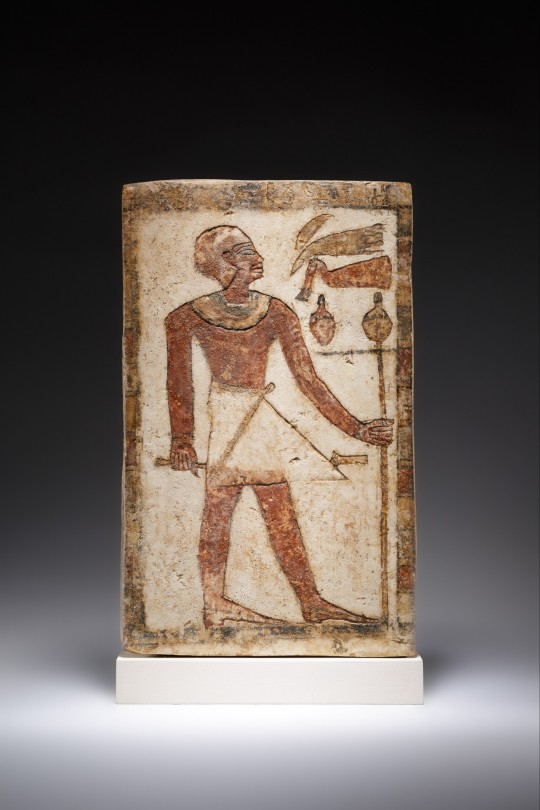
~ Stela of a Man.
Period: Middle Kingdom, 11th Dynasty
Date: ca. 2030–1981 B.C.
Place oforigin: Egypt, Upper Egypt, Thebes, Deir el-Bahri, Cemetery 100, Tomb TT 114, MMA excavations, 1926–27
Medium: Limestone, paint
#ancient#ancient art#history#museum#archeology#ancient egypt#ancient sculpture#ancient history#archaeology#egyptian#egyptology#Egypt#stela of a man#11th Dynasty#middle kingdom#thebes#ca. 2030 b.c.#ca. 1981 b.c.
634 notes
·
View notes
Text


Lintel of Amenemhat I and Deities
Metropolitan Museum of Art, Egyptian Art Collection
On view at The Met Fifth Avenue in Gallery 108
Period: Middle Kingdom
Dynasty: Dynasty 12
Reign: reign of Amenemhat I–Senwosret I
Date: ca. 1981–1952 B.C.
Geography: From Egypt, Memphite Region, Lisht North, Pyramid Temple of Amenemhat I, MMA excavations, 1907
Medium: Limestone, paint
Dimensions: H. 36.8 × W. 172.7 × D. 13.3 cm, 183.7 kg (14 1/2 × 68 × 5 1/4 in., 405 lb.)
Accession Number: 08.200.5
30 notes
·
View notes
Text

A Necklace of four strands of beads and amulets - Met Museum Collection
Inventory Number: 22.3.324 Middle Kingdom, Dynasty 11, ca. 2051–2030 B.C. Location Information: From Egypt, Upper Egypt, Thebes, Deir el-Bahri, Tomb of Myt, Temple of Mentuhotep II, Pit 18, mummy of Myt, MMA excavations, 1921
Description:
This brightly colored set of necklaces belonging to a young girl are remarkable not only for their technically brilliant manufacture, the drilled stone beads being quite tiny.
Mayet was only five when she was buried among the older female members of the King Mentuhotep II’s court in his funerary complex at Deir el Bahri. Although her burial was simple, her necklaces, including two others of gold and carnelian ball beads, are some of the finest jewelry that survives from this period and the signs of wear on the beads indicate Mayet, or perhaps another woman, wore them during their lifetime.
#A Necklace of four strands of beads and amulets#necklace#necklaces#jewelry#middle kingdom#dynasty 11#upper egypt#thebes#deir el-bahri#deir el bahri#tomb of myt#temple of mentuhotep II#met museum#22.3.324#MKJ
9 notes
·
View notes
Photo
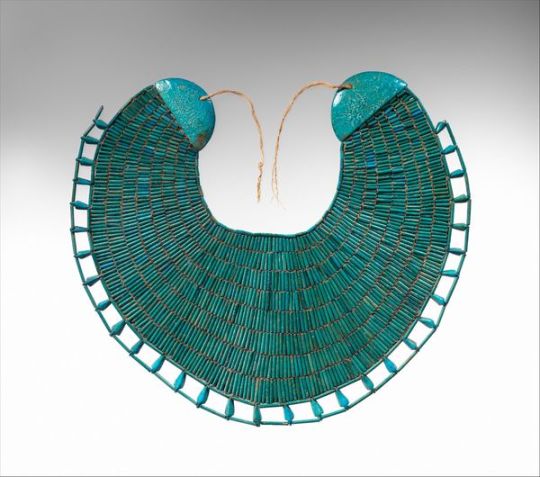
Broad Collar of Wah.
Middle Kingdom, Dynasty 12, reign of Amenemhat I, early,
ca. 1981–1975 B.C. Upper Egypt, Thebes, Southern Asasif, Tomb of Wah (MMA 1102), Mummy, in wrappings on chest, MMA excavations, 1920.
Faience, linen thread.
Dimensions:H. 34.5 cm (13 9/16 in.); W. 39 cm (15 3/8 in.)The Met
22 notes
·
View notes
Text

3500 lat temu Title: Artist's Sketch of a Sparrow Period: New Kingdom / Dynasty: Dynasty 18 Reign: Joint reign of Hatshepsut and Thutmose III Date: ca. 1479–1458 B.C. Geography: From Egypt, Upper Egypt, Thebes, Deir el-Bahri, Hatshepsut Hole, MMA excavations, 1922–23 Medium: Limestone, paint Dimensions: H. 6.6 cm (2 5/8 in.); W. 10.6 cm (4 3/16 in.); Th. 2.4 cm (15/16 in.) Museum excavations, 1922-1923. Acquired in the division of finds, 1923. THE MET
0 notes
Text
Artist's Sketch of a Sparrow. Depicts a delicate sparrow perched on a slender branch.
The artist has captured the bird's essence with swift, flowing lines, showcasing its small, rounded body and distinctive beak.
The sparrow's feathers are suggested through light, feathery strokes, giving the impression of softness and movement in the breeze.
Its wings are subtly hinted at, slightly folded against its body, conveying a sense of calm and tranquility.
The eye, though simple in its design, exudes a sense of curiosity and liveliness, adding a spark to the otherwise understated sketch.
Overall, the artist has captured the essence of this small bird, portraying its beauty and grace through minimalist yet expressive lines.
Museum excavations, 1922-1923. Acquired in the division of finds, 1923.
Title: Artist's Sketch of a Sparrow Period: New Kingdom Dynasty: Dynasty 18 Reign: Joint reign of Hatshepsut and Thutmose III Date: ca. 1479–1458 B.C. Geography: From Egypt, Upper Egypt, Thebes, Deir el-Bahri, Hatshepsut Hole, MMA excavations, 1922–23 Medium: Limestone, paint Dimensions: H. 6.6 cm (2 5/8 in.); W. 10.6 cm (4 3/16 in.); Th. 2.4 cm (15/16 in.) Credit Line: Rogers Fund, 1923 Accession Number: 23.3.7 Winlock, Herbert E. 1923. "The Egyptian Expedition 1922–1923." In The Metropolitan Museum of Art Bulletin, vol. 18, no. 12, part 2 (December), p. 35, fig. 29.
Oppenheim, Adela 2010. "Sperling." In Falken, Katzen, Krokodile: Tiere im Alten Ägypten: Aus den Sammlungen des Metropolitan Museum of Art, New York, und des Ägyptischen Museums Kairo, edited by Dorothea Arnold. Zurich: Museum Rietberg, p. 82, no. 79.
#edisonmariotti @edisonblog
.br
Esboço artístico de um pardal. Retrata um delicado pardal empoleirado num galho delgado.

O artista capturou a essência do pássaro com linhas rápidas e fluidas, mostrando seu corpo pequeno e arredondado e seu bico distinto.
As penas do pardal são sugeridas através de pinceladas leves e plumadas, dando a impressão de suavidade e movimento na brisa.
Suas asas são sutilmente insinuadas, levemente dobradas contra o corpo, transmitindo uma sensação de calma e tranquilidade.
O olho, embora simples em seu design, exala uma sensação de curiosidade e vivacidade, adicionando uma faísca ao esboço discreto.
No geral, o artista capturou a essência deste pequeno pássaro, retratando a sua beleza e graça através de linhas minimalistas mas expressivas.
Escavações do museu, 1922-1923. Adquirida na divisão de achados, 1923.
Título: Esboço artístico de um pardal Período: Novo Reino Dinastia: Dinastia 18 Reinado: Reinado conjunto de Hatshepsut e Tutmés III Data: ca. 1479–1458 a.C. Geografia: Do Egito, Alto Egito, Tebas, Deir el-Bahri, Hatshepsut Hole, escavações MMA, 1922–23 Médio: calcário, tinta Dimensões: H. 6,6 cm (2 5/8 pol.); L. 10,6 cm (4 3/16 pol.); º. 2,4 cm (15/16 pol.) Linha de crédito: Fundo Rogers, 1923 Número de Acesso: 23.3.7 Winlock, Herbert E. 1923. "A Expedição Egípcia 1922–1923." No Boletim do Museu Metropolitano de Arte, vol. 18, não. 12, parte 2 (dezembro), p. 35, fig. 29.
Oppenheim, Adela 2010. "Sperling". Em Falken, Katzen, Krokodile: Tiere im Alten Ägypten: Aus den Sammlungen des Metropolitan Museum of Art, Nova York, und des Ägyptischen Museums Kairo, editado por Dorothea Arnold. Zurique: Museu Rietberg, p. 82, não. 79.
1 note
·
View note
Text










The Park, NV (No. 2)
T-Mobile Arena is a multi-purpose indoor arena in Paradise, Nevada, United States. Opened on April 6, 2016, it is the home arena of the Vegas Golden Knights of the National Hockey League (NHL). A joint venture between MGM Resorts International and Anschutz Entertainment Group (AEG), T-Mobile Arena is situated on the Las Vegas Strip behind the New York-New York and Park MGM casino hotels.
T-Mobile Arena has hosted various sports and entertainment events, with the latter including concerts, award shows, and beauty pageants. The arena has also hosted various combat sport events, including mixed martial arts (MMA), boxing, and professional wrestling. MMA promoter Ultimate Fighting Championship (UFC) signed a long-term tenancy agreement with T-Mobile Arena in 2017, under which it agreed to host four events per-year over the next seven years.
The project broke ground on May 1, 2014, followed by the demolition of existing buildings, and excavation of an oval area for the arena. The final steel beam of the structure was placed on May 27, 2015.
In January 2016, T-Mobile US announced that it had acquired the naming rights to the new arena in a multi-year contract. The arena held its grand opening on April 6, 2016, with a concert by Las Vegas natives The Killers, Shamir and Wayne Newton. Country music artists Martina McBride and Cam performed at a soft opening on March 31, 2016.
In 2016, the National Hockey League awarded an expansion team to a Las Vegas ownership group led by Bill Foley, with T-Mobile Arena as its home venue.
Source: Wikipedia
#The Park in Las Vegas#Bliss Dance by Marco Cochrane#shade structures by Jerry van Eyck#fountain#T-Mobile Arena#3780 South Las Vegas Boulevard#Populous#exterior#Paradise#travel#original photography#vacation#tourist attraction#landmark#summer 2022#USA#cityscape#Nevada#architecture#detail#façade#Clark County#evening light#public art#sculpture#I really love the first pic
0 notes
Photo
Model Cattle stable from the tomb of Meketre
Middle Kingdom, Dynasty 12, early reign of Amenemhat I, ca. 1981–1975 B.C.
From Egypt, Upper Egypt, Thebes, Southern Asasif, Tomb of Meketre (TT 280, MMA 1101), MMA excavations, 1920
Plastered and painted wood, gesso
Dimensions: l. 72.5 cm (28 9/16 in); w. 57 cm (22 7/16 in); h. 28.5 cm (11 1/4 in) average height of cattle: 18 cm (7 1/16 in.)
This model of a stable was found with twenty three other models of boats, gardens, and workshops in a hidden chamber at the side of the passage leading into the rock cut tomb of the royal chief steward Meketre, who began his career under King Nebhepetre Mentuhotep II of Dynasty 11 and continued to serve successive kings into the early years of Dynasty 12. Cattle are being fattened for slaughter in this stable. Four oxen feed from a manger in the large stall; two others are being hand fed by the stablemen from a pile of fodder and a sack of grain in the room in front. One of the cattle is so fat he can no longer stand. By the door sits an overseer with a baton in his hand. All the accessible rooms in the tomb of Meketre had been robbed and plundered already during Antiquity; but early in 1920 the Museum's excavator, Herbert Winlock, wanted to obtain an accurate floor plan of the tomb's layout for his map of the Eleventh Dynasty necropolis at Thebes and, therefore, had his workmen clean out the accumulated debris. It was during this cleaning operation that the small hidden chamber was discovered, filled with twenty-four almost perfectly preserved models. Eventually, half of these went to the Egyptian Museum, Cairo, and the other half came to the Metropolitan Museum in the partition of finds. Collection of the Metropolitan Museum of Art
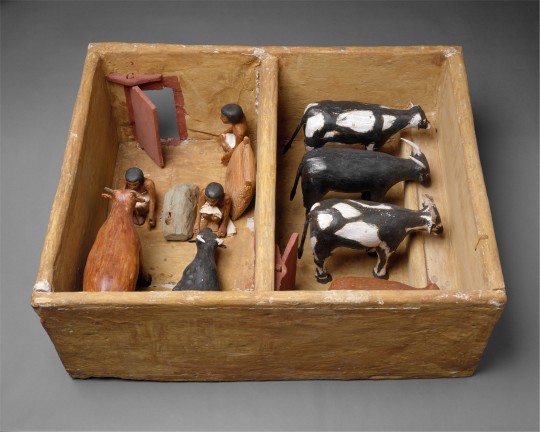
Model cattle stable from the tomb of Meketre, 1981BC-1975BC, Thebes, Egypt.
195 notes
·
View notes
Text
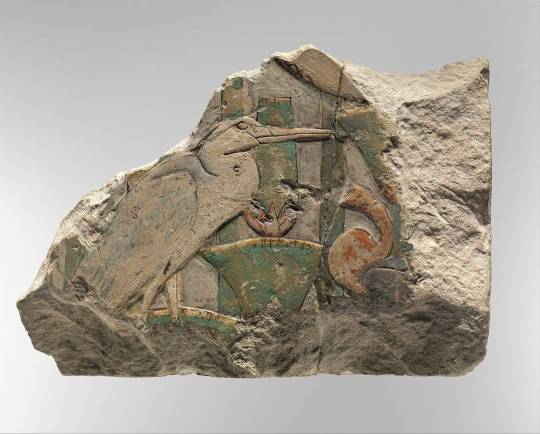
Relief Fragment with Two Birds in the Papyrus Thicket
Period: Middle Kingdom
Dynasty: Dynasty 12
Reign: reign of Senwosret I or Amenemhat II
Date: ca. 1925–1900 B.C.
Geography: From Egypt, Memphite Region, Lisht North, Cemetery, MMA excavations, 1906–07
Medium: Limestone, paint
This exquisitely carved and delicately painted relief shows a gray heron and another bird, possibly a purple heron, perched within a mass of papyrus plants. In the upper right, the curved form with painted X-marks likely represents a nest that contained either baby birds or a mother sitting on eggs, both of which are common vignettes in marsh scenes. Originally part of a larger tableau, the small fragment is jewel-like in its fine detail.
0 notes
Photo

Relief fragment, tomb of Meketre
ca. 1981–1975 B.C.
View full size image
#Limestone#paint#Middle Kingdom#From Egypt#Upper Egypt#Thebes#Southern Asasif#Tomb of Meketre (TT 280#MMA 1101)#MMA excavations#1920
1 note
·
View note
Photo

Hatshepsut’s granite statues were discovered shattered to pieces at Deir el Bahari Hatshepsut (𓇋𓏠𓈖𓎸𓏏𓄂𓏏𓀼𓏪) “imn-ẖnmt ḥA.t-šps.wt” ‘United with Amun, Foremost of Nobel Ladies’ is kneeling in adoration and offering to small jars of oil to the state god 𓊹 “nṯr” and her divine father 𓇋𓏏�� “it” - Amun-Ra 𓇋𓏠𓈖𓇳𓏤 “ı͗mn-rˁ”. The fragments of these statues 𓂙𓏏𓏭𓀾 “ḫnty” were discovered during several seasons of excavations by the Museum’s Egyptian Expedition. The statues were reassembled as much as possible in the field (see attached photographs). Fragments of the statues given to the Metropolitan Museum were reconstructed in New York by attaching them to metal armatures and filling in the gaps with plaster. Although the plaster has been tinted to blend with the stone, it is possible to distinguish the original stone fragments from the plaster fill. Title: Large Kneeling Statue of Hatshepsut Period: New Kingdom Dynasty: Dynasty 18 Reign: Joint reign of Hatshepsut and Thutmose III Date: ca. 1479–1458 B.C. Geography: From Egypt, Upper Egypt, Thebes, Deir el-Bahri, Senenmut Quarry, MMA excavations, 1927–28 Medium: Granite Dimensions: H. 261.5 cm (102 15/16 in.); W. 80 cm (31 1/2 in.); D. 137 cm (53 15/16 in.) 𓋹𓎬𓋹𓎬𓋹𓎬𓋹𓎬𓋹𓎬𓋹𓎬𓋹𓎬𓋹𓎬𓋹𓎬𓋹𓎬𓋹𓎬𓋹𓎬𓋹𓎬𓋹𓎬𓋹𓎬𓋹𓎬𓋹𓎬𓋹𓎬𓋹 📸 1, 3-10 @egyptologylessons 𓋹𓊽𓋴𓆖𓎛𓇳𓎛 © ( 📸 2 @metmuseum and description) 𓊁𓊁𓊁𓊁𓊁𓊁𓊁𓊁𓊁𓊁𓊁𓊁𓊁𓊁𓊁𓊁𓊁𓊁𓊁𓊁 #Ancientegypt #ägypten #egyptianhistory #egyptology #hieroglyphs #egypte #egitto #埃及 #مصر #egipto #이집트 #hatshepsut #statue #deirelbahari #metropolitanmuseumofart #granite (at The Metropolitan Museum of Art, New York) https://www.instagram.com/p/CjaNfmiuPPN/?igshid=NGJjMDIxMWI=
#ancientegypt#ägypten#egyptianhistory#egyptology#hieroglyphs#egypte#egitto#埃及#مصر#egipto#이집트#hatshepsut#statue#deirelbahari#metropolitanmuseumofart#granite
37 notes
·
View notes
Text

~ Amulet with ankhs.
Period: Middle Kingdom; 12th-13th Dynasty
Date: ca. 1981–1640 B.C.
Place of origin: Egypt, Memphite Region, Lisht North (Tomb 954, Burial 954L, MMA excavations, 1921–22)
Medium: Quartz, gold
#ancient art#ancient#history#museum#archeology#ancient history#archaeology#egyptology#egypt#egyptian#ancient Egypt#ankh#amulet with ankhs#12th dynasty#13th dynasty#middle kingdom#ca. 1981 b.c.#ca. 1640 b.c.#quartz#gold
1K notes
·
View notes
Text


Model Bakery and Brewery from the Tomb of Meketre
Metropolitan Museum of Art, Egyptian Art Collection
On view at The Met Fifth Avenue in Gallery 105
Period: Middle Kingdom
Dynasty: Dynasty 12
Reign: reign of Amenemhat I, early
Date: ca. 1981–1975 B.C.
Geography: From Egypt, Upper Egypt, Thebes, Southern Asasif, Tomb of Meketre (TT 280, MMA 1101), serdab, MMA excavations, 1920
Medium: Wood, gesso, paint, linen
Dimensions: l. 73 cm (28 3/4 in); w. 55 cm (21 5/8 in); h. 29 cm (11 7/16 in) average height of figures: 21 cm (8 1/4 in.)
Credit Line: Rogers Fund and Edward S. Harkness Gift, 1920
Accession Number: 20.3.12
42 notes
·
View notes
Text

Book of the Dead for the Chantress of Amun Nauny - Met Museum Collection
Inventory Number: 30.3.31 Third Intermediate Period, Dynasty 21, ca. 1050 B.C. Location Information: From Egypt, Upper Egypt, Thebes, Deir el-Bahri, Tomb of Meritamun (TT 358, MMA 65), burial of Nauny, first corridor, inside Osiris figure, MMA excavations, 1928–29
Description:
This papyrus was part of the burial of Nauny, a Chantress of the god Amun-Re who died in her seventies. She also bore the title "king's daughter," which probably means that she was a child of the High Priest of Amun and titular king of the Theban area, Painedjem I.
On the papyrus are images and texts from a number of spells. The central scene illustrates Spell 125, better known as the Judgment of Osiris or The Weighing of the Heart. Nauny is in the Hall of Judgment. (...) Behind Nauny stands the goddess Isis, both wife and sister of Osiris. She is identified by the hieroglyph above her head.
#Book of the Dead for the Chantress of Amun Nauny#third intermediate#dynasty 21#upper egypt#thebes#deir el bahri#deir el-bahri#tomb of meritamun#met museum#30.3.31#womens clothing#TIWC#deities#deitiesw#aset
6 notes
·
View notes
Photo
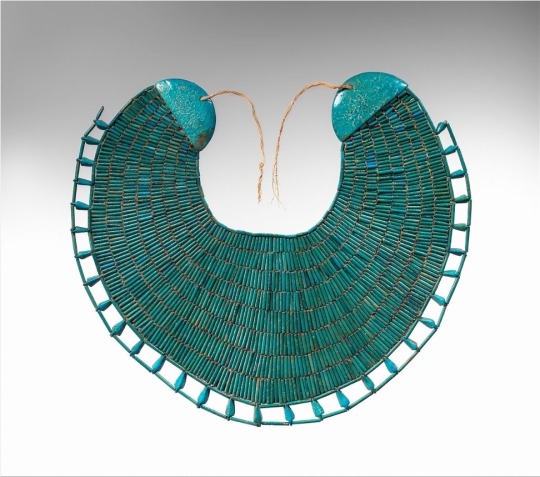
~ Broad Collar of Wah.
Period: Middle Kingdom, 12th Dynasty; reign of Amenemhat I (early)
Date: ca. 1981–1975 B.C.
Place of origin: Egypt, Upper Egypt, Thebes, Southern Asasif, Tomb of Wah (MMA 1102), Mummy, in wrappings on chest, MMA excavations, 1920
Medium: Faience, linen thread
44 notes
·
View notes
Photo

Floral Garlands of Nany
Medium: Persea leaves, lotus petals, palm leaves, linen thread
Date: ca. 1050 B.C. (Third Intermediate Period)
Geography: From Egypt, Upper Egypt, Thebes, Deir el-Bahri, Tomb of Meritamun (TT 358, MMA 65), Mummy of Meritamun, MMA excavations, 1928–29
Accession Number: 30.3.33a
2 notes
·
View notes